
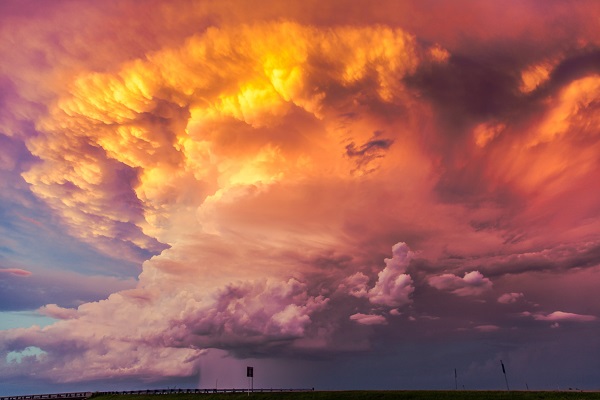
The IPCC Intergovernmental Panel on Climate Change) is planning to release the first of four reports in its 6th Assessment Report (6AR) on Monday, 9 August, 2021.
I believe the largest question will be whether the IPCC, this time, adequately accounts for risk.
From Wikipedia:
- The IPCC was established in 1988 by the World Meteorological Organization (WMO) and the United Nations Environment Programme (UNEP) and was later endorsed by the United Nations General Assembly. Membership is open to all members of the WMO and UN.[5]
The IPCC produces reports that contribute to the work of the United Nations Framework Convention on Climate Change (UNFCCC), the main international treaty on climate change.[6][7] The objective of the UNFCCC is to “stabilize greenhouse gas concentrations in the atmosphere at a level that would prevent dangerous anthropogenic (human-induced) interference with the climate system.”
(Emphasis added)As such it will attempt to facilitate the work of the UNFCCC, which is the political body that established the Paris Agreement. Every seven years (late by one year through COVID) it summarises and assesses the scientific research literature on climate, traditionally in four reports:
- AR6 Climate Change 2021: The Physical Science Basis
- AR6 Climate Change 2022: Mitigation of Climate Change
- AR6 Climate Change 2022: Impacts, Adaptation and Vulnerability
- AR6 Synthesis Report: Climate Change 2022
The Paris Agreement was to endeavour to keep global heating to two degrees, and if possible to limit it to 1.5°C.
To this end in 2018 the IPCC produced a special report Global Warming of 1.5°C.
Their plan was to give us a 50% chance of staying below 1.5°C by reaching net zero emissions by 2050, with negative emissions thereafter.
Those odds, for a livable planet for future generations are derisively inadequate.
Problem is, global heating is already dangerous. 1.5°C is consistently promoted as “avoiding the worst effects” of climate change. However, it contains the prospect of losing 90% of the world’s coral reefs (70-99%), inundating most of the Pacific Islands, the Torres Strait Islands, Maldives etc, apart from major cities an ports, river deltas, fertile land and coastal communities everywhere, increasing wildfires and extreme weather, and so on.
Climate change has been smacking us in the face in recent years. Carbon Brief’s State of the Climate: 2021 finds no cheer. In fact the basic driver as measured by CO2 at Mauna Loa is curving upwards, the rate of increase is increasing:
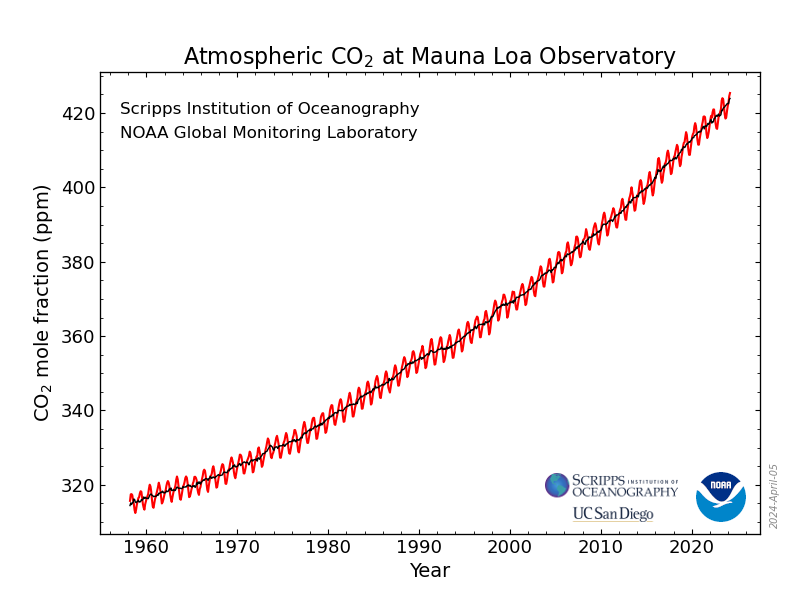
John Davidson, our inhouse engineer, calculates we’ll hit 484.46 ppm by 2050 if we carry on that way.
So some have been calling the IPCC out, either directly or the ‘net zero by 2050’ target, for example:
- Graham Readfern in Scientists who Issued ‘Climate Emergency’ Declaration in 2019 Now say Earth’s Vital Signs are Worsening
That’s William Ripple et al in World Scientists’ Warning of a Climate Emergency 2021 . Also see Ignoring climate change will yield ‘untold suffering,’ panel of 14,000 scientists warns
- David Spratt and Ian Dunlop in “Net zero 2050”: a dangerous delusion
- Michael Mazengarb & Giles Parkinson in Net zero target for 2050 is too slow, and a strategy for climate failure
- Alan Kohler in
Kohler cites a News Daily article
which cites Professor Will Steffen, one of Australia’s leading climate scientists as saying “Net zero by 2050 is a furphy”:
- “It means they can put off meaningful action now, because it’s three decades away. The real critical action that will be the determining factor in where climate goes is between now and 2030.”
Moreover:
- Professor Steffen said not only is the 2050 debate behind the times, but that a net-zero goal is actually needed by 2035 – 15 years earlier – to limit global warning to 1.5 degrees Celsius. (Emphasis added)
Spratt and Dunlop have been saying that the equilibrium temperature increase for the emissions in the atmosphere now, not 484 ppm in 2050, is over two degrees . It is well recognised that aerosols produced by fossil fuels dampen warming about half a degree, and recent studies have shown that 1.5°C will likely be reached under current conditions by the early 2030s.
The IPCC report has generally seen tipping points as not being a factor this side of 1.5°C. However, there is one large tipping point, an elephant in the room, they have consistently handled badly.
Mark Kaufman at Mashable ponders What Earth was like last time CO2 levels were this high. We may well be on our way to the Pliocene, 1.8 to 5 million years ago, when, he says, sea level rise was 30 feet, about 9 metres. He also links to a Nature article Dimitru et al Constraints on global mean sea level during Pliocene warmth which puts SLR back then at 17.4 metres, or 23.4 metres during the Pliocene Climatic Optimum, when the temperature was around 4°C higher than preindustrial, a level when widespread social and political breakdown is expected.
Reaching planetary equilibrium assumes that atmospheric greenhouse levels will continue at the same levels for some time, so the earth system adjusts over 2-3,000 years. Where we are now is illustrated by the following slides from John Englander’s Moving to Higher Ground: Rising Sea Level and the Path Forward.
The first is three graphs, showing how CO2, temperature and sea level rise synchronise over the ages:
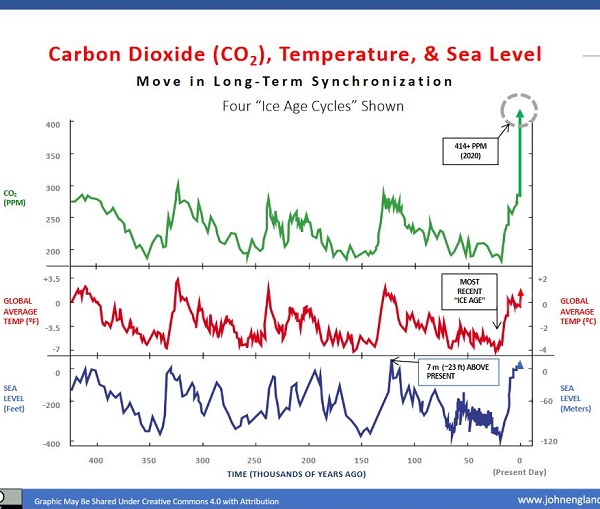
A couple of thousand years is next to nothing in geological time. However, the last peak was the Eocene interglacial, when sea levels peaked 6-9 metres higher than now around 120,000 years ago. The last dip, around 22,000 years ago saw sea levels 120 metres lower than now. Complete deglaciation will give us another 70 metre or a bit more.
It seems apparent that we would be lucky to get away with a mere 23 metres.
Englander says that with SLR and property, for example, an insurer provides a policy for what is likely to happen in the next year. An owner and a financer more likely has a 30-year view. However, urban planner, infrastructure planners and policy makers concerned with our future, should be thinking of 100 to 150 years. As citizens concerned about the planet in the age of the Anthropocene, we should be thinking of thousands of years and beyond.
He says we should always take the worst case scenario and add a safety margin, perhaps 60%.
He says the insurance company will know what is likely to happen in the next year. for 30 years he says, start with a metre, and for 100 years, start with 3 metres. However, these are global averages. At any point on the map the number will be higher or lower depending on the circumstances.
Having studied the science, he believes our current greenhouse emissions and ocean heat storage will commit us to 20 metres (midpoint) and that multimetre SLR is inevitable in the next 500 years. Nothing humans do will stop it.
The IPCC approach is to look at past trends and forecast the future in terms of proven science facts and forecasts through models. He says of the IPCC:
From the IPCC’s start in 1988, the carefully stated policy was effectively only to include facts that had been peer-reviewed in a professional journal, that were represented as objective values, with a high degree of certainty, with the year 2100 as the benchmark.
In terms of ice sheet decay or collapse they only consider what will happen, not what could happen.
Antarctica, which holds 88% of potential SLR is largely omitted from their calculations. In their worst case, business-as-usual case, the IPCC allowed just 15 cm of SLR from Antarctica by 2100. Overall in their 2019 report on the oceans the IPCC projected 0.6 to 1.1 meters of global SLR by 2100 if greenhouse gas emissions remain at high rates (RCP8. 5). Yet by 2300 on that scenario seas could stand as much as 5 meters higher as this chart from NASA shows:
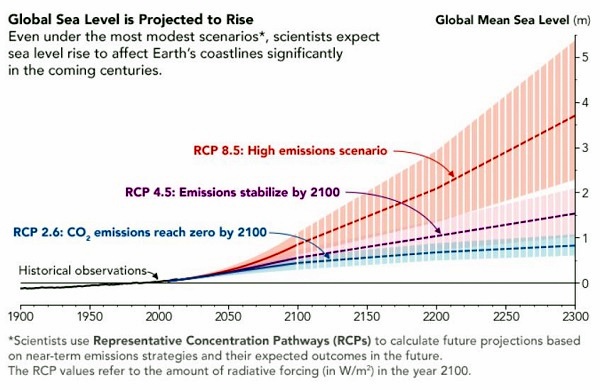
Quite frankly, it has been problematic that institutions like NASA all over the world give out this IPCC information minus the fine print telling what it leaves out.
Englander gives us this graph, which comes from a US Government source:
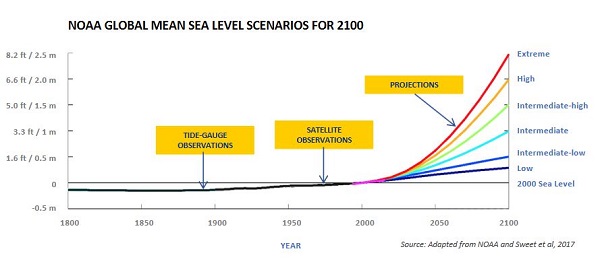
Why such a huge variance?
Englander says, and Gavin Schmidt, head of the NASA GISS climate research, because no-one knows. The modelling of individual ice sheet decay is at a primitive stage. We know they interact with each other, but we have no chance of quantifying this interaction.
That is not surprising. If we look at say 150 years of data, that relates to 2 million years as 39 seconds relates to a year (my maths, so do the calcs yourself). Yet we do know that there is trouble afoot if we look at this Englander graph:
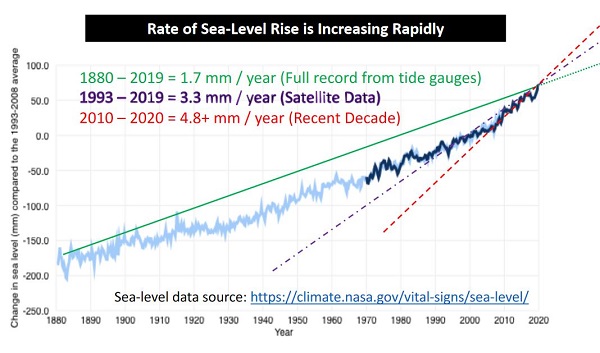
Ice loss from Greenland has increased by seven times in the last 20 years, Antarctica by five.
Englander says:
-
Recent studies from 2017 to 2019 by the US government, the British government, California, and New York State are all now looking at high-end scenarios of 8 to 10 feet (2.5 to 3 metres) for SLR this century.
Prof David Karoly told Fran Kelly this morning that global warming was occurring faster than previously thought (again!), that the IPCC understood that 1.5 degrees would be reached by the early 2030s, that developing countries no longer had the privilege of polluting their way to prosperity, that we needed to reach net zero as soon as possible, that there would be much more focus on regional conditions and variance because of improvements in data collection and modelling, and that more attention would be paid to risk.
No mention of sea level rise, there hardly ever is. However, what we really need is to recognise that net zero is a step along the way, that if we are to cope with inevitable sea level rise, which is beginning to impinge and threaten all over the world. We need to realise that our best chance of a livable planet, and hope for generations emerging and yet to come, is to dial down emissions to something like 280 ppm.
We need to throw off the warming blanket, and allow the giant store of heat in the oceans gradually dissipate into the ether.
Time to wrap. Sea level rise for me has been the elephant in the room. What the IPCC recommends this time will ultimately be revealed in the second and third reports on mitigation, impacts adaptation and vulnerability. In June we had IPCC steps up warning on climate tipping points in leaked draft report.
That turned out to be a discussion draft of the mitigation report, not due until next year. However, the reaction of individual experts was more than interesting, see EXPERT REACTION: Climate tipping points described in leaked IPCC Report. I’ll finish with Prof John Quiggin:
- “The problem with tipping points is that we won’t know we have passed them until it is too late. But we do know that every reduction in emissions reduces the chance that we pass thresholds from which we can’t return and that the sooner we start reducing emissions, the better our chances will be. In this context, those who stand against action for short-term political and economic gain will be judged harshly in the future, and quite possibly in the near future.”
Crimes against humanity, and against life on earth, I say.
Quiggin has looked at the evidence and turned from climate optimism to climate pessimism. Englander says that when the situation looks hopeless, the opportunity is there for humans to excel.
So far politicians and scientist operating as the UNFCCC and the IPCC have failed to prevent dangerous anthropogenic interference.
As I sign off a reaction from some who should know in This is the most sobering report card yet on climate change and Earth’s future. Here’s what you need to know.
3900 pages from 214 scientists has just hit the deck. In the next week or two I’ll attempt to summarise what is significant and new.
(AU The Age) ‘We Need More Urgency’: Top Renewable Group Warns Against Paying To Keep Coal Alive

If you want to tackle the beast yourself, download IPCC AR6 WG1 Science from here.
My first impression is that they have changed their whole basis for scenarios by going from four Representative Concentration Pathways (RCPs) 2.6 (low emissions), 4.6 and 6.0 (medium emissions) and 8.5 (high emissions) to five “Shared Socioeconomic Pathways” (SSPs) which are supposed to take into account where people live on the planet and what they do, based on newer climate models, see Nerilie Abram et al here, and especially Briefing note 12: How sensitive is the Earth’s temperature to the amount of carbon dioxide in the atmosphere?
There are a few posts where climate scientists hang out at RealClimate.
There has been some bright-siding, eg. Pep Canadell, who said we humans are still in control, whereas he would/should know that we are not in terms of SLR, and not in terms of stories like this – A critical ocean system may be heading for collapse due to climate change, study finds where:
Human-caused warming has led to an “almost complete loss of stability” in the system that drives Atlantic Ocean currents, a new study has found — raising the worrying prospect that this critical aquatic “conveyor belt” could be close to collapse.
If the Atlantic Meridional Overturning Circulation (AMOC) shuts down, and it’s looking like it could, then the change would be irreversible in human lifetimes, Europe would become cold and stormy, sea level rise would be boosted all along the USA east coast, but the warmer oceans would still chew away at the West Antarctica’s glaciers, and the CO2 blanket all over the globe would still trap heat. For impacts on weather, see also from Wikipedia:
Global warming could, via a shutdown of the thermohaline circulation, trigger cooling in the North Atlantic, Europe, and North America.[9][10] This would particularly affect areas such as the British Isles, France and the Nordic countries, which are warmed by the North Atlantic drift.[11][12] Major consequences, apart from regional cooling, could also include an increase in major floods and storms, a collapse of plankton stocks, warming or rainfall changes in the tropics or Alaska and Antarctica, more frequent and intense El Niño events due to associated shutdowns of the Kuroshio, Leeuwin, and East Australian Currents that are connected to the same thermohaline circulation as the Gulf Stream, or an oceanic anoxic event — oxygen (O
2) below surface levels of the stagnant oceans becomes completely depleted – a probable cause of past mass extinction events.[13]
The study was published in Nature on 5 August 2021.
Which illustrates another feature of these reports. They comprise a magnificent summary of research, but are some months out of date when published. In spite of that they will be quoted as gospel for the next 7 years.
John, there is no comment appearing!
‘How high above sea level am I?’ If you’ve googled this, you’re likely asking the wrong question — an expert explains.
The message is more complex that we think
Good to see the comment worked.
John, it’s a good summary of many of the points Englander makes He has a 25-page chapter on Different places, different solutions. I’m, thinking the Qld government should have a unit with expertise to assist local government, property developers and property owners with SLR.
I think Nerilie Abram might have been involved in writing the IPCC report.
People with a lot more expertise than I have are taking their time to assess the report. However, I have difficulty with this:
A further 15-25cm of sea level rise is expected by 2050, with little sensitivity to greenhouse gas emissions between now and then. Beyond 2050, however, the amount of sea level rise will largely depend on our future emissions.
In a low-emissions scenario, we can expect sea levels to rise to about 38cm above the 1995–2014 average by the year 2100. In a high-emissions scenario this is expected to more than double to 77cm.
So SLR is accelerating now, is expected to do so in the future, but will somehow taper off if we level emissions at around 450ppm.
At that level they seem to think surface warming and thermal expansion will stop, and only continue if we continue to increase emissions.
And they have still punted ice sheet decay into a category which says, ‘don’t worry, it will only be a problem with high emissions, and then a low probability one.’
Personally, I don’t buy that when over 90% of the heat has gone into the ocean, when the Thwaites Glacier has not yet even been initially studied yet, and we got 6-9m back 120kya with only 300ppm.
It seems that back then the big mover was W Antartica, followed by Greenland, followed by some loss from East Antarctica.
Brian: Look at the Milankovitch cycles and the Vostok ice core results.
There is a lot of rapid changes there that hint of tipping points in various places. We should take the precautionary approach by bringing emissions down as fast as we can.
The whole problem is made worse by the growing human plague. It makes it harder to peaceably move people when climate change makes it harder for some parts of the earth to support high populations.
Perspective: Professor Jeffrey Sachs
https://youtu.be/TeKeGzeZ_6Q
Good on Geoffrey Sachs. About 20 years ago I discovered that the US gave more in military aid to Israel than it gives in aid to the whole continent of Africa.
Pertinent to this thread, the IPCC base their forecast modelling on five different socio-economic/cultural/population scenarios. I hope to do a post on this soon, but I’m quite certain the future will be different from any of those scenarios.
The one that gives the best climate outcome has as a prime feature that inequality will disappear from the world.
Utopian dreaming, that’s what it is.
John, sorry, missed your comment of 13 August.
Andrew Glikson’s point was that the climate was now being forced about 30 times harder than it has been by the Milankovitch cycles. Harder than any time since the asteroid strike 65mya that finished the dinosaurs.
I think the Milankovitch cycles started affecting the climate soon after the Panama Isthmus closed.
There is an article in a recent New Scientist which finds IPCC modelling inadequate because it (a) doesn’t take into account the rate of change of climate forcing, and (b) because it has a mainly 100-yr focus.